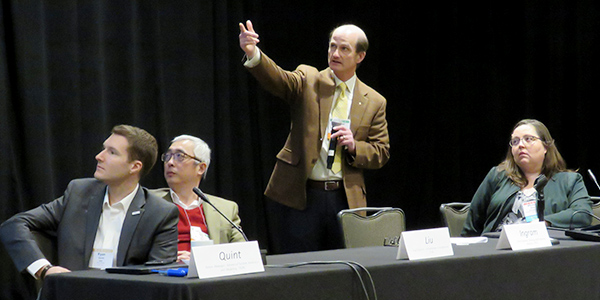By Rich Heidorn Jr.
WASHINGTON — State regulators this week endorsed Institute of Electrical and Electronics Engineers’ updated standard 1547-2018 on the interconnection and interoperability of distributed energy resources.
The National Association of Regulatory Utility Commissioners’ board of directors approved a resolution Wednesday recommending state commissions adopt the standard. The vote came at NARUC’s Winter Policy Summit, where cybersecurity and reliability were the subject of numerous discussions. (See Cybersecurity, Resilience Talks Highlight NARUC Meeting.)
Published in April 2018, IEEE’s standard requires DER to perform grid-support functions for voltage, frequency, communications and controls “to ensure that increasing levels of DERs are reliable at both the distribution and bulk power system levels, and can be visible to grid operators,” NARUC said.
DER equipment compliant with the standard is expected to be available next year.
“Delaying implementation of IEEE 1547-2018 could result in new DERs being connected to the grid using legacy technical requirements and standards that could prevail for the duration of the DER’s lifetime,” NARUC said. “Significant logistical and legal barriers exist to modifying DER interconnection requirements post-installation, such that it is preferable to apply the desired DER configuration at the time of initial DER installation.”
NERC also backed the standard in a draft reliability guideline and the Electric Power Research Institute, National Renewable Energy Laboratory, Regulatory Assistance Project, Interstate Renewable Energy Council and National Rural Electric Cooperative Association have produced resources to help states implementing the standard, which will require integrating it into interconnection tariffs.
During a panel discussion on the standard Sunday, Ryan Quint, NERC’s senior manager of advanced system analytics and modeling, said planners and real-time operators in North America are currently relying on estimates of DER because of a limited information.
“Under low-penetration conditions, it’s a reasonable estimate,” he said. But he added that CAISO is growing increasingly concerned “because it has so much behind-the-meter generation that is not readily visible. Those forecasts are getting a little less solid, and they’re getting faced with new challenges because they don’t have the knobs that they used to be able to turn.
“If they’re already having problems, and they have requirements that every new rooftop [in California] must have a mini solar plant on it that we can’t see and can’t control,” problems will increase, Quint said. “We don’t necessarily need to control those things, but making sure they meet requirements and are tracked, and we know where they are and we can forecast them into the future — those things become really important.
“We’re going to need to change the paradigm of the way we operate the overall grid into the future,” he continued. “In North America, we’re not so sure how we’re going to do that. In Europe, for example, we have distribution system operators that coordinate a lot of this at the distribution level that are running real-time tools like the grid operator is doing.”





